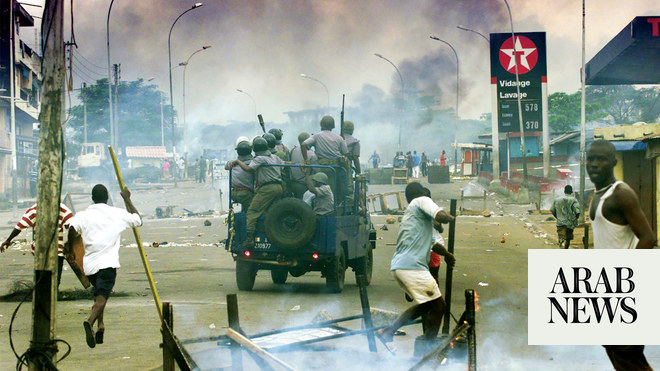
When the independent Russian TV station Dozhd, or TV Rain, was forced off air by the government earlier this month, its final act was to cut to footage of the ballet Swan Lake. “That was epic trolling,” says cultural historian Simon Morrison, author of the book Bolshoi Confidential. It was the same footage that was played on every Russian TV channel as tanks rolled into Moscow during the attempted coup in August 1991.
“When the putsch happened in the Gorbachev era, the screens turned to Swan Lake because they didn’t want people to know what was happening,” explains Morrison. “So [Dozhd] was trolling them for mass censorship. ‘You don’t want people to know what’s happening in Ukraine – here’s your Swan Lake!’”
After Russia invaded Ukraine, UK tours by the Russian State Ballet of Siberia and Moscow’s Bolshoi Ballet were cancelled, the latest example of ballet’s role as a political football and diplomatic tool over many decades.
As a wordless art, dance travels well. With strong links to the Kremlin, the Bolshoi has been hailed as Russia’s “secret weapon” by former prime minister Dmitry Medvedev, sent abroad to “achieve our goals”, he said, unabashed about using the ballet studio as an arsenal of soft power.
Ballet holds a revered place in Russian culture across all sections of society. A Russian I once knew mainly for his love of football turned out to be equally knowledgable about ballet. I was surprised by his interest. “Why wouldn’t you be,” he said, “when you’re the best in the world?”
Ballet wasn’t born in Russia (its roots are in Italy and France) but it was at the Imperial Russian Ballet in St Petersburg in the late 19th century that most people agree classical ballet reached its zenith, with Marius Petipa and Lev Ivanov’s creation of the ballets – Swan Lake, Sleeping Beauty, The Nutcracker – that remain the backbones of the repertoire. The dancers of the Mariinsky (formerly the Imperial, then Kirov) are famed for their willowy physiques, the corps de ballet militaristically drilled in magical unison; the Bolshoi for their giant leaps and flashy virtuosity.
The ballets and the companies themselves reflected political ideology. “The hierarchy of the court is represented in the ranks of the company,” says Morrison. “Petipa put on stage a model of behaviour and decorum within a space that was highly controlled – ultra-civilised but ultra-repressive at the same time.” The ballets were then reframed for the Soviet era, the massed movement of the corps de ballet “easy to convert into the Soviet experience”, he says, “where the individual desire and aspiration is defined through the collective”. Under director Yuri Grigorovich from 1964 to 1995, Bolshoi ballets such as Spartacus and Ivan the Terrible demonstrated Soviet might and morals. Censors had their say and plots were changed – famously conjuring up a happy ending to the great tragedy of Swan Lake.
The first tour of the Bolshoi to London, which took place in 1956, was not predominantly about propaganda but designed for financial gain. It was a hot ticket: people started queueing for seats three days before the box office opened (when the Bolshoi toured the US in 1959, touts reportedly sold tickets for up to $1,200 in today’s money). The whole thing was almost jeopardised by an incident involving a Soviet discus thrower who was accused of stealing five hats from a shop on Oxford Street, but after some diplomatic wrangling it went ahead, and reviews were mostly ecstatic. (Which was just as well: in 1959, Soviet authorities made known their dissatisfaction with mild criticism in the US press, and only a few years ago a Bolshoi press representative queried a lukewarm review of my own in this paper.)
A year after the Bolshoi’s UK visit, the British ballerina Beryl Grey became the first western ballerina to guest with the company (in Swan Lake, of course). In her autobiography she recalls a woman sitting at the end of the hotel corridor surveilling everyone’s movements, but also the hugely warm welcome from the company’s star dancers, who joined her for dinner with the British ambassador. She told me in 2018: “It was the first time any of the Bolshoi had been to the British embassy, so that was a good breakthrough. I felt I did some good.” It wasn’t a complete thaw in relations: Grey revisited the theatre the following year and security wouldn’t even let her through the stage door.
American Ballet Theatre visited the USSR in 1960, and New York City Ballet were in Moscow in 1962 when the Cuban missile crisis kicked off; they were told that the US embassy had no power to intervene if the dancers were interned there. NYCB dancers remembered a tepid response at the premiere – the audience not wanting to seem too appreciative about anything American – but applause became increasingly enthusiastic, even as political tensions were rising. Meanwhile, the Bolshoi were in America. “As long as they keep dancing and the diplomats keep talking, we’ll have no war,” said producer Sol Hurok at the time. Straight after the crisis was resolved, the New York Times reported President Kennedy’s first social outing was to the Bolshoi’s Swan Lake. He reportedly clapped louder and longer than anyone in his section.
Did these tours genuinely aid cultural understanding? Morrison thinks so. “In the Soviet period, where our knowledge of people in the Soviet Union was very distant and they were represented as an empire and a menace, you actually saw dancers on stage and they seemed genuine. They really cared, they were dancing their tails off and that was great. It humanised them,” he says.
Those tours offered a chance for cultural exchange, but also opportunities for Soviet dancers to defect to the west, dealing a political blow to the USSR when Rudolf Nureyev told a French policeman at Le Bourget airport in Paris in 1961: “I want to stay and to be free.” The fiercely charismatic, wild whirlwind of a dancer brought a huge boost in popularity and publicity to ballet in this country when he settled in London. He was followed by Natalia Makarova, who defected in London in 1970, and Mikhail Baryshnikov, who defected in Toronto in 1974. They notably all came from St Petersburg. The Muscovites were more closely controlled, teachers paid to report on their charges, families at home essentially held as collateral. “The Bolshoi was, for a while, the Stalinist court ballet,” says Morrison.
Baryshnikov became a piece of Hollywood propaganda in the 1985 film White Nights, when he and the great tap dancer Gregory Hines (whose character has unbelievably defected in the opposite direction, to Russia) risk it all for American freedom. The same year, the Soviets made Flight 222 dramatising the 1979 defection of Bolshoi dancer Alexander Godunov, whose wife chose to return to Russia. Godunov stayed in the US and began an acting career with roles in Witness and Die Hard, but died of alcoholism aged 45.
Nowadays, the two big Russian companies regularly visit London. When they tour, Morrison points out, they dance more conservative rep than at home, giving people the “exotica” they want. Whereas once it was orientalist fantasies such as La Bayadère, “now they want the Soviet, it’s the new exoticism”. Dancers move more freely between countries and artistic styles, but are now caught in politics once more. Yorkshire-born Xander Parish, who moved from the Royal Ballet to be a principal with the Mariinsky in 2010, said this week he was leaving Russia. Meanwhile, Ukrainian ballerina Lesia Vorotnyk was pictured holding a machine gun.
Former Bolshoi director Alexei Ratmansky left a half-finished ballet in Moscow and returned to the US where he has been artist in residence at American Ballet Theatre since 2009. He has family in Kyiv and has been marshalling international artists to speak out for peace on his Facebook page, including Russians Natalia Osipova and Vladimir Shklyarov. The Royal Ballet’s Vadim Muntagirov dedicated his opening performance of Swan Lake on 1 March to the people of Ukraine and the Royal Opera House has been playing the Ukrainian national anthem every night before shows.
Some dancers with Russian connections feel it’s too risky to speak frankly – and in the music world, Bolshoi conductor Tugan Sokhiev has resigned rather than publicly take sides – but one of the Bolshoi’s star dancers Olga Smirnova has left the country and joined Dutch National Ballet after posting on Telegram her shame at Russia’s actions, saying “I am against war with all the fibres of my soul ... We may not be at the epicenter of the military conflict, but we cannot remain indifferent to this global catastrophe.”
Some argue that cancelling performances has more of an impact on the artists than the regime. “On one level it’s humiliating,” says Morrison. “On the other hand, this kind of ‘cancel Russia’ campaign plays into the regime’s hands: ‘See, they are against us, they’re out to get us.’”
Ballet may be the ultimate escapist art form, but some realities we can’t escape. “I have a photo on my phone of a protester being dragged away in front of a ballet advertisement,” says Morrison. “There’s Russia, right there: the riot police in front of the dancers.”












